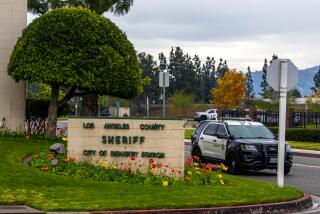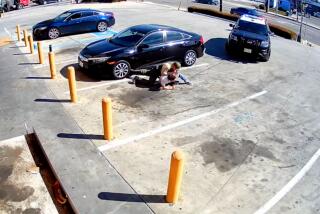Long Beach hate-trial lawyers rest their cases
- Share via
The prosecution and defense in the Long Beach hate-crime trial rested Thursday, and plan to begin what promises to be a lengthy set of closing arguments next week.
Shortly before the lawyers ended their cases, the sole defendant to testify -- 18-year-old Anthony Ross -- stepped down after calmly responding to allegations from Deputy Dist. Atty. Andrea Bouas.
Ross and nine girls -- ages 12 to 18 -- are accused of taking part in the mob beating of three white women on Halloween. The 10 black youths are charged with assault with intent to cause great bodily harm; eight face a hate-crime enhancement to their sentence because racial slurs were allegedly made before the attack.
Ross said he did not beat the women, but instead came to their rescue.
On Thursday, Bouas accused him of beating victim Laura Schneider, 19, so hard that he was scared he had killed her.
“At the time you said, ‘What did I do? What did I do?’ You were afraid Laura Schneider was dead.”
“No ma’am,” Ross replied.
Ross testified that he said, “What did I do?” when a man who has been depicted as a good Samaritan told him to leave.
Bouas sought to introduce a school record from when Ross was 14 years old that she said showed he was suspended for fighting with girls. The judge said the time it would take to bring all the people in who could testify about the record outweighed its value as evidence. The judge also refused to allow Ross’ page on the MySpace social networking website to be introduced as evidence that he was linked to the Crips gang.
Bouas has accused Ross, who is a track athlete and has no criminal record, of being a Crip.
To show that Long Beach police were trying to make a gang connection at the outset, a tape of officers interviewing Bouas’ star witness was played in court Thursday. In the Nov. 16 interview, Officer Richard Austin asked Kiana Alford what the assailants were wearing.
“Were they displaying red?” Austin asked.
She said they were.
“Besides the red cars?” Austin asked.
Another affirmative.
“They have red rags on ... or ... ?” Austin continued.
“No, they didn’t have any rags or nothing.... “
“Red shirts?”
“They had, um, yeah, red shirts, they had on white shirts, red jackets with Rocawear signs on them.... “
On the witness stand, Alford did not testify about the assailants wearing red.
The tape was offered to show Alford’s testimony last month was consistent with her earlier police interview. Yet there were inconsistencies as well, including what the assailants were wearing, how many of the victims were knocked unconscious, where she was during the attack and which victim lost her cellphone.
The tape also questions the accuracy of the police reports officers wrote to summarize the interviews and have been a key element to the case.
On the tape, a detective asked Alford if she was scared when two girls approached her and said, “What’s up?”
“I mean, no, not necessarily, no, I wasn’t intimidated,” Alford said.
“No, I mean, were you afraid that they were gonna do something to you and your kids?” the detective asked.
“Oh, yeah.”
In his report, he wrote: “I asked her if she was afraid when the two girls approach her; and she stated, ‘Yes’ and believed they would harm her kid and her sister.”
More to Read
Sign up for Essential California
The most important California stories and recommendations in your inbox every morning.
You may occasionally receive promotional content from the Los Angeles Times.














